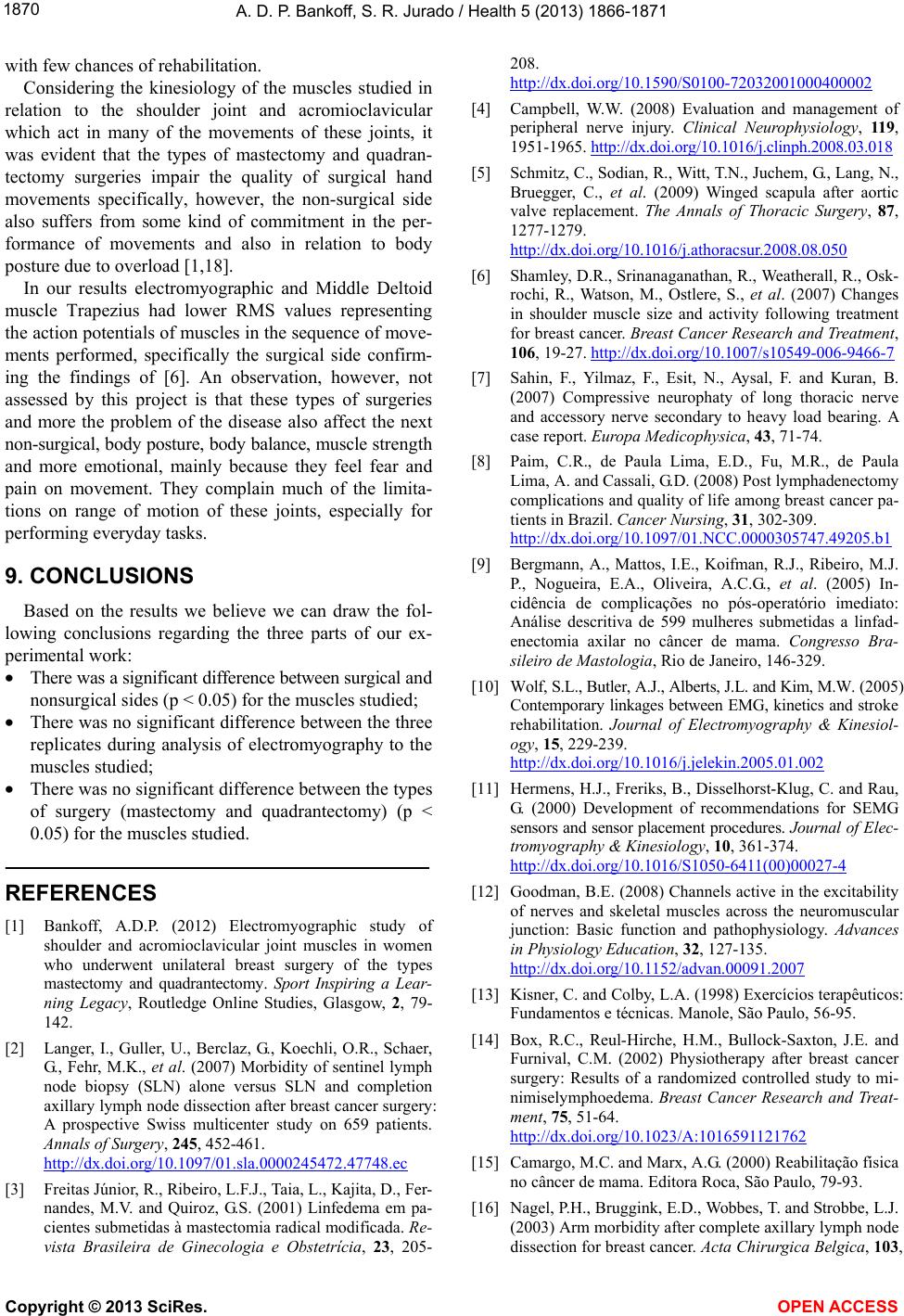
A. D. P. Bankoff, S. R. Jurado / Health 5 (2013) 1866-1871
1870
with few chances of rehabilitation.
Considering the kinesiology of the muscles studied in
relation to the shoulder joint and acromioclavicular
which act in many of the movements of these joints, it
was evident that the types of mastectomy and quadran-
tectomy surgeries impair the quality of surgical hand
movements specifically, however, the non-surgical side
also suffers from some kind of commitment in the per-
formance of movements and also in relation to body
posture due to overload [1,18].
In our results electromyographic and Middle Deltoid
muscle Trapezius had lower RMS values representing
the action potentials of muscles in the sequence of move-
ments performed, specifically the surgical side confirm-
ing the findings of [6]. An observation, however, not
assessed by this project is that these types of surgeries
and more the problem of the disease also affect the next
non-surgical, body posture, body balance, muscle stre ng th
and more emotional, mainly because they feel fear and
pain on movement. They complain much of the limita-
tions on range of motion of these joints, especially for
performing everyday tasks.
9. CONCLUSIONS
Based on the results we believe we can draw the fol-
lowing conclusions regarding the three parts of our ex-
perimental work:
• There was a sign ifican t d iffere nce be tween su rgic al an d
nonsurgical sides (p < 0.05) for the muscles studied;
• There was no significant difference between the three
replicates during analysis of electromyography to the
muscles studied;
• There was no significant difference between the types
of surgery (mastectomy and quadrantectomy) (p <
0.05) for the muscles studied.
REFERENCES
[1] Bankoff, A.D.P. (2012) Electromyographic study of
shoulder and acromioclavicular joint muscles in women
who underwent unilateral breast surgery of the types
mastectomy and quadrantectomy. Sport Inspiring a Lear-
ning Legacy, Routledge Online Studies, Glasgow, 2, 79-
142.
[2] Langer, I., Guller, U., Berclaz, G., Koechli, O.R., Schaer,
G., Fehr, M.K., et al. (2007) Morbidity of sentinel lymph
node biopsy (SLN) alone versus SLN and completion
axillary lymph node dissection after breast cancer surgery:
A prospective Swiss multicenter study on 659 patients.
Annals of Surgery, 245, 452-461.
http://dx.doi.org/10.1097/01.sla.0000245472.47748.ec
[3] Freitas Júnior, R., Ribeiro, L.F.J., Taia, L., Kajita, D., Fer-
nandes, M.V. and Quiroz, G.S. (2001) Linfedema em pa-
cientes submetidas à mastectomia radical modificada. Re-
vista Brasileira de Ginecologia e Obstetrícia, 23, 205-
208.
http://dx.doi.org/10.1590/S0100-72032001000400002
[4] Campbell, W.W. (2008) Evaluation and management of
peripheral nerve injury. Clinical Neurophysiology, 11 9,
1951-1965. http://dx.doi.org/10.1016/j.clinph.200 8.03.018
[5] Schmitz, C., Sodian, R., Witt, T.N., Juchem, G., Lang, N.,
Bruegger, C., et al. (2009) Winged scapula after aortic
valve replacement. The Annals of Thoracic Surgery, 87,
1277-1279.
http://dx.doi.org/10.1016/j.athoracsur.2008.08.050
[6] Shamley, D.R., Srinanaganathan, R., Weatherall, R., Osk-
rochi, R., Watson, M., Ostlere, S., et al. (2007) Changes
in shoulder muscle size and activity following treatment
for breast cancer. Breast Cancer Research and Treatment,
106, 19-27. http://dx.doi.org/10.1007/s10549-006-9466-7
[7] Sahin, F., Yilmaz, F., Esit, N., Aysal, F. and Kuran, B.
(2007) Compressive neurophaty of long thoracic nerve
and accessory nerve secondary to heavy load bearing. A
case report. Europa Medicophysica, 43, 71-74.
[8] Paim, C.R., de Paula Lima, E.D., Fu, M.R., de Paula
Lima, A. and Cassali, G.D. (2008) Post lymphadenectomy
complications and quality of life among breast cancer pa-
tients in Brazil. Cancer Nursing, 31, 302-309.
http://dx.doi.org/10.1097/01.NCC.0000305747.49205.b1
[9] Bergmann, A., Mattos, I.E., Koifman, R.J., Ribeiro, M.J.
P., Nogueira, E.A., Oliveira, A.C.G., et al. (2005) In-
cidência de complicações no pós-operatório imediato:
Análise descritiva de 599 mulheres submetidas a linfad-
enectomia axilar no câncer de mama. Congresso Bra-
sileiro de Mastologia, Rio de Janeiro, 146-329.
[10] Wolf, S.L., Butler, A.J., Alberts, J.L. and Kim, M.W. (2005)
Contemporary linkage s between EMG, kinetics and str oke
rehabilitation. Journal of Electromyography & Kinesiol-
ogy, 15, 229-239.
http://dx.doi.org/10.1016/j.jelekin.2005.01.002
[11] Hermens, H.J., Freriks, B., Disselhorst-Klug, C. and Rau,
G. (2000) Development of recommendations for SEMG
sensors and sensor placement procedures. Journal of Elec -
tromyography & Kinesiology, 10, 361-374.
http://dx.doi.org/10.1016/S1050-6411(00)00027-4
[12] Goodman, B.E. (2008) Channels active in the excitability
of nerves and skeletal muscles across the neuromuscular
junction: Basic function and pathophysiology. Advances
in Physiology Education, 32, 127-135.
http://dx.doi.org/10.1152/advan.00091.2007
[13] Kisner, C. and Colby, L.A. (1998) Exercícios terapêuticos:
Fundamentos e técnicas. Manole, São Paulo, 56-95.
[14] Box, R.C., Reul-Hirche, H.M., Bullock-Saxton, J.E. and
Furnival, C.M. (2002) Physiotherapy after breast cancer
surgery: Results of a randomized controlled study to mi-
nimiselymphoedema. Breast Cancer Research and Treat-
ment, 75, 51-64.
http://dx.doi.org/10.1023/A:1016591121762
[15] Camargo, M.C. and Marx, A.G. (2000) Reabilitação física
no câncer de mama. Editora Roca, São Paulo, 79-93.
[16] Nagel, P.H., Bruggink, E.D., Wobbes, T. and Strobbe, L.J.
(2003) Arm morbidity after complete axillary lymph node
dissection for breast cancer. Acta Chirurgica Belgica, 103,
Copyright © 2013 SciRes. OPEN A CCESS